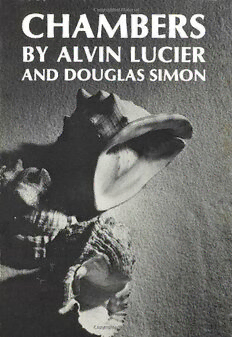
Chambers: Scores by Alvin Lucier PDF
Preview Chambers: Scores by Alvin Lucier
CHAMBERS This page intentionally left blank CHAMBERS Scores by ALVIN LUCIER Interviews with the composer by DOUGLAS SIMON Wesleyan University Press Middletown, Connecticut Scores copyright © 1980 by Alvin Lucier Interviews copyright © 1980 by Alvin Lucier and Douglas Simon Several of these scores and interviews have appeared in similar or different form in Arts in Society; Big Deal; The Painted Bride Quar- terly; Parachute; Pieces 3; The Something Else Yearbook; Source Magazine; and Individuals: Post-Movement Art in America, edited by Alan Sondheim (New York: E.P. Dutton, 1977). Typography by Jill Kroesen The authors gratefully acknowledge the support of a Wesleyan University Project Grant. Library of Congress Cataloging in Publication Data Lucier, Alvin. [Works. Selections] Chambers. Concrete music. Bibliography: p. Includes index. 1. Concrete music. 2. Chance compositions. 3. Lucier, Alvin. 4. Composers—United States- Interviews. I. Simon, Douglas, 1947- II. Title. M1470.L72S5 789.9'8 79-24870 ISBN 0-8195-5042-6 Distributed by Columbia University Press 136 South Broadway, Irvington, N.Y. Printed in the United States of America First edition For Ellen Parry and Wendy Stokes This page intentionally left blank CONTENTS Preface ix 1. Chambers 1 2. Vespers 15 3. "I Am Sitting in a Room" 29 4. (Hartford) Memory Space 41 5. Quasimodo the Great Lover 53 6. Music for Solo Performer 67 7. The Duke of York 79 8. The Queen of the South and Tyndall Orchestrations 93 9. Gentle Fire 109 10. Still and Moving Lines of Silence in Families of Hyperbolas 127 11. Outlines and Bird and Person Dyning 145 12. Music in a Long Thin Wire 159 Bibliography 171 Index 173 This page intentionally left blank PREFACE I first met Alvin Lucier in 1968 when he came to Wesleyan University, where I was an undergraduate, to offer a course in new music. He was still teaching at Brandeis University then and traveled to Middle- town, Connecticut, once a week from Waltham, Massachusetts. It was an exciting class that had a strong influence on my own ideas, and when I chose a subject for an honors thesis in 1969, I decided to write on Alvin's work. At that time, I was most familiar with his piece Chambers. I had watched it taking shape in 1968 and had helped perform it more than once by the time I began my project, so it seemed a good can- didate for my choice of subject matter. A major portion of the thesis was to be devoted to a careful, objective description of a single per- formance of Chambers at the Museum of Modern Art in New York, in which I had performed, and I felt I needed a block of personal information from Alvin to balance that. If the description of the piece were to be of a specific performance, the idea of a specific conversation, an interview, seemed a promising parallel. And so it was. In December of 1968, we sat in the greenroom of the Slosberg Music Center at Brandeis, a very resonant, intimate space, and talked with each other. I have a clear memory of the effort involved in making oneself understood with a tape recorder running, but Alvin and I were both pleased with the results. When we examined the transcription, we found more to please us. Alvin felt his ideas were stimulated and organized by the questions and enjoyed seeing his thoughts on paper. I appreciated that, and also found that his observations and, perhaps more importantly, his ix
